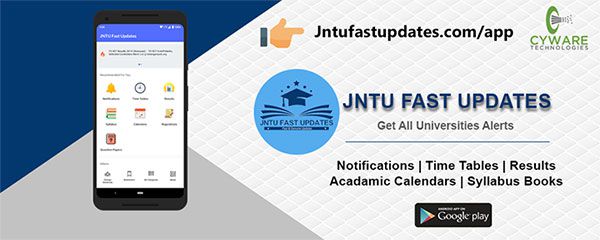JNTUK R19 2-1 Electronic Devices and Circuits Material PDF Download
Students those who are studying JNTUK R19 ECE, EEE Branches, Can Download Unit wise R19 2-1 Electronic Devices and Circuits Material/Notes PDFs below.

JNTUK R19 2-1 Electronic Devices and Circuits Material PDF Download
Course Objectives: This course is designed to:
- To learn and understand the basic concepts of semiconductor physics.
- Study the physical phenomena such as conduction, transport mechanism and electrical characteristics of different diodes.
- To learn and understandthe application of diodes as rectifiers with their operation and characteristics with and without filters arediscussed.
- Acquire knowledge about the principle of working and operation of Bipolar Junction Transistor and Field Effect Transistor and theircharacteristics.
- To learn and understandthe purpose of transistor biasing and itssignificance.
- Small signal equivalent circuit analysis of BJT and FET transistor amplifiers and compare differentconfigurations.
UNIT-1
Review of Semi Conductor Physics: Hall effect, continuity equation, law of junction, Fermi Dirac function, Fermi level in intrinsic and extrinsic Semiconductors
Junction Diode Characteristics: energy band diagram of PN junction Diode, Open circuited pn junction, Biased p-n junction, p-n junction diode,current components in PN junction Diode, diode equation, V-I Characteristics, temperature dependence on V-I characteristics, Diode resistance, Diode capacitance.
Download UNIT-1 Material PDF | Reference-2 | Ref-3
UNIT-2
Special Semiconductor Devices: Zener Diode, Breakdown mechanisms, Zener diode applications, LED, Varactor Diode, Photodiode, Tunnel Diode, UJT, PN-PN Diode, SCR. Construction, operation and V-I characteristics.
Rectifiers and Filters: Basic Rectifier setup, half wave rectifier, full wave rectifier, bridge rectifier,derivations of characteristics of rectifiers, rectifier circuits-operation, input and output waveforms, Filters, Inductor filter(Series inductor), Capacitor filter(Stunt inductor), πFilter,comparison of various filter circuits in terms of ripple factors.
Download UNIT-2 Material PDF | Reference-2 | Ref-3
UNIT-3
Transistor Characteristics: BJT: Junction transistor, transistor current components, transistor equation, transistor configurations, transistor asan amplifier, characteristics of transistor in Common Base, Common Emitter and Common Collector configurations, Ebers-Moll model of a transistor, punch through/ reach through, Photo transistor, typical transistor junction voltage values.
FET: FET types, construction, operation, characteristicsµ, gm, rdparameters, MOSFET-types, construction, operation,characteristics, comparison between JFET and MOSFET.
Download UNIT-3 Material PDF | Reference-2
UNIT-4
Transistor Biasing and Thermal Stabilization : Need for biasing, operating point, load line analysis, BJT biasing- methods, basic stability, fixed bias, collector to base bias, self bias, Stabilization against variations in VBE, Ic, and β, Stability factors, (S,S’ ,S’’), Bias compensation, Thermal runaway, Thermalstability. FET Biasing- methods and stabilization.
Download UNIT-4 Material PDF | Reference-2
UNIT-5
Small Signal Low Frequency Transistor Amplifier Models: BJT: Two port network, Transistor hybrid model, determination of h-parameters, conversion of h-parameters,generalized analysis of transistor amplifier model using h-parameters, Analysis of CB, CE and CC amplifiers using exact and approximate analysis, Comparison of transistor amplifiers. FET: Generalized analysis of small signal model, Analysis of CG, CS and CD amplifiers, comparison of FETamplifiers.
Download UNIT-5 Material PDF | Reference-2
Text Books:
- Electronic Devices and Circuits- J. Millman, C. Halkias, Tata Mc-Graw Hill, SecondEdition,2007
- Electronic Devices and Circuits-K. Lal Kishore, BS Publications, FourthEdition, 2016.
- Electronics devices & circuit theory- Robert L.Boylestad and LouiNashelsky, Pearson/Prentice hall, tenth edition, 2009
Reference Books:
1.Integrated Electronics-J. Millman, C. Halkias, Tata Mc-Graw Hill, SecondEdition,2009
2.Electronic Devices and Integrated Circuits – B.P. Singh, Rekha, Pearson publications,
3.Electronic Devices and Circuits-Salivahanan, Kumar, Vallavaraj, Tata Mc-Graw Hill, 4 thEdition,2008.
Course Outcomes:
- Apply the basic concepts of semiconductor physics.
- Understand the formation of p-n junction and how it can be used as a p-n junction as diode in different modes of operation.
- Know the construction, working principle of rectifiers with and without filters with relevant expressions and necessary comparisons.
- Understand the construction, principle of operation of transistors, BJT and FET withtheir V-I characteristics in different configurations.
- Know the need of transistor biasing, various biasing techniques for BJT and FET and stabilization concepts with necessary expressions.
- Perform the analysis of small signal low frequency transistor amplifier circuits using BJT and FET in different configurations.

320-x100(1).gif)

3rd,4th ,5th units are not downloading